A Diachronic Wind
A Diachronic Wind begins with the sound of a woman’s voice. In clear and calm diction, she reads the Bureau of Meteorology’s forecast for the coming days. Fine and warm, afternoon sea breezes will maintain a slight to choppy sea; satisfactory conditions will continue. The effect is soothing, assuring. With the help of computation and meteorological analysis, a sense of security grows around tomorrow. At a base level, an attunement to the weather reflects a desire to structure time, especially the future; to challenge uncertainty and perceive threats.
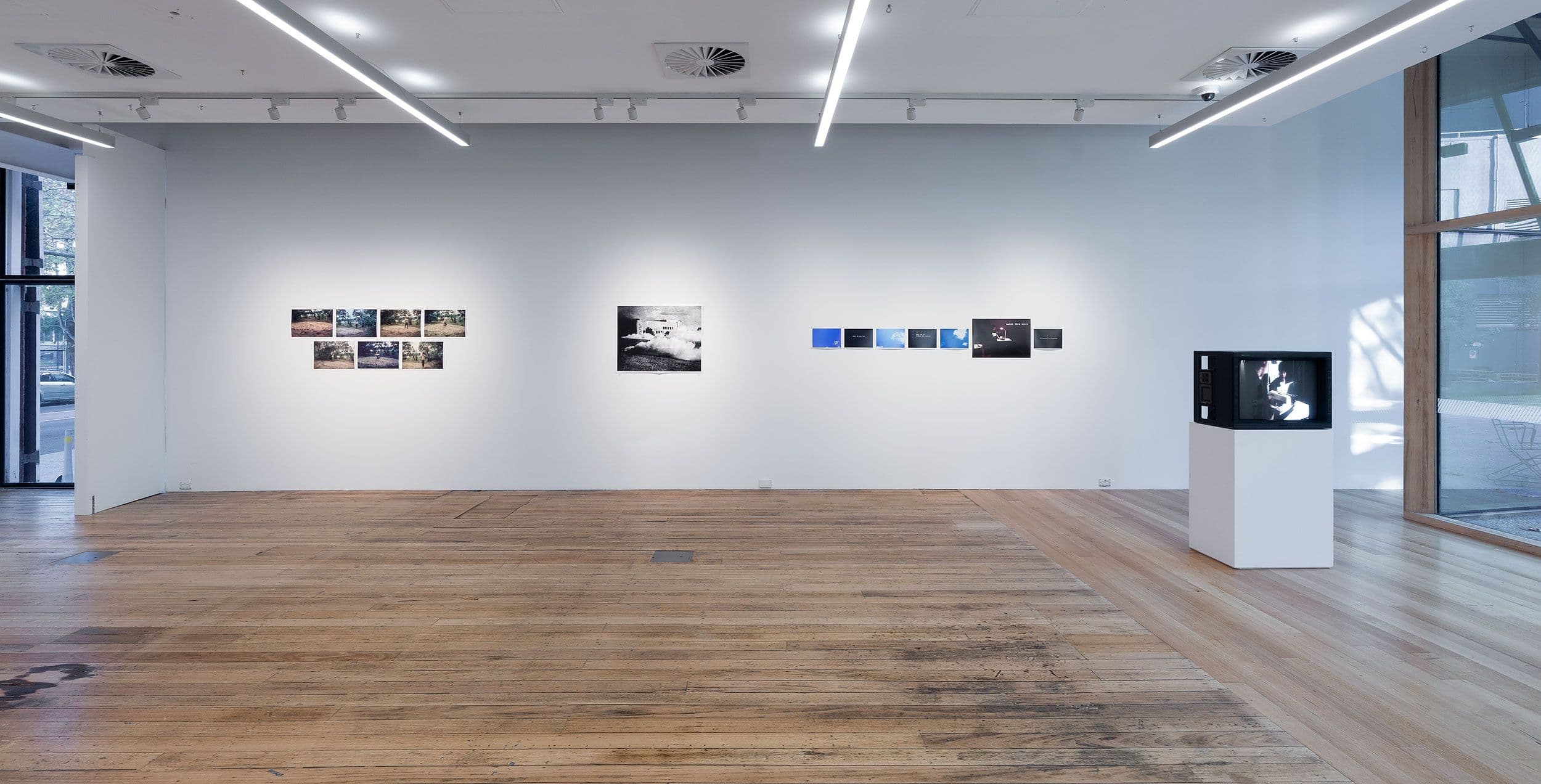
A Diachronic Wind, installation view, MADA Gallery, Monash University, Naarm/Melbourne, 2022, photo: Christian Capurro.
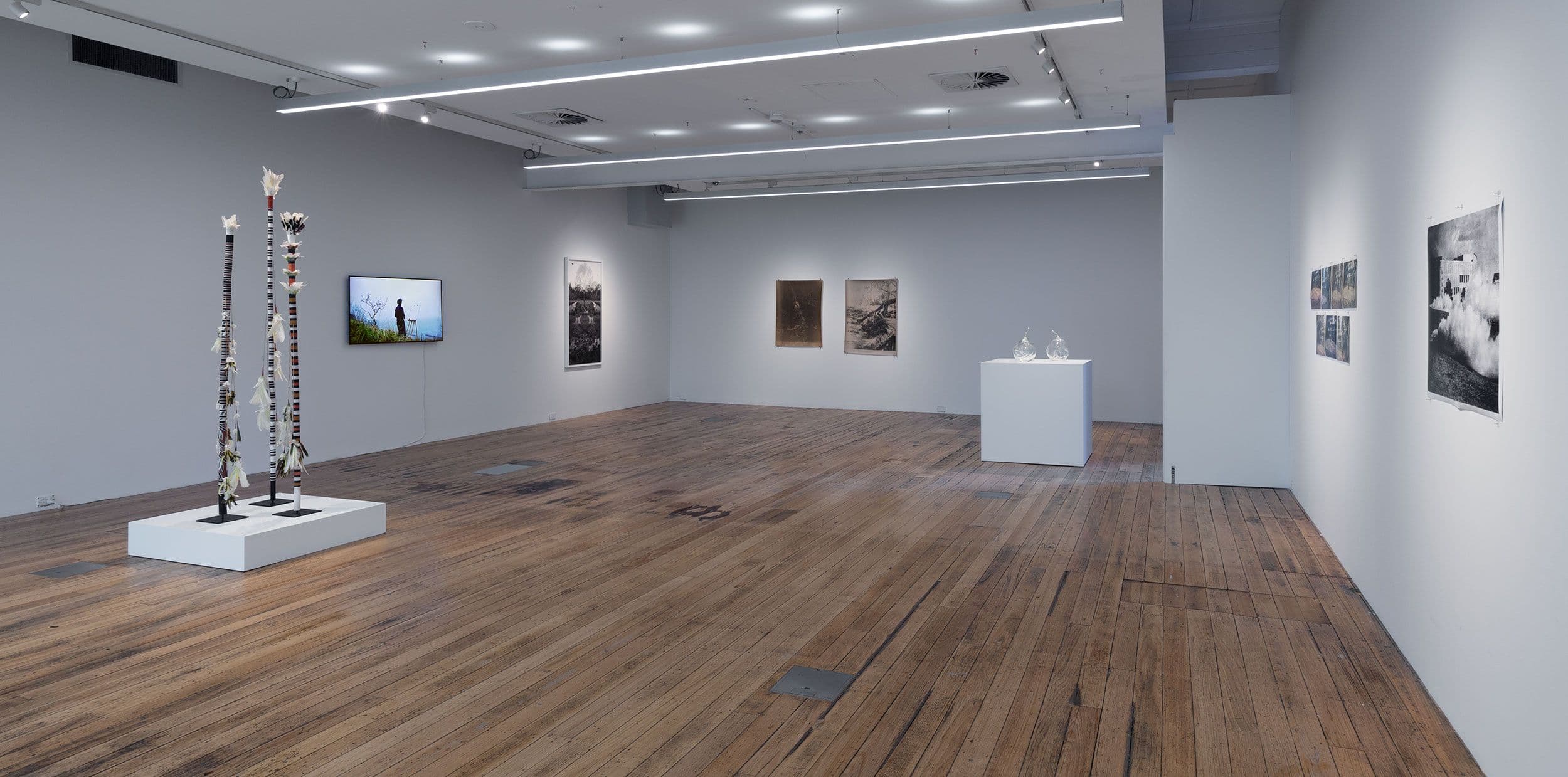
A Diachronic Wind, installation view, MADA Gallery, Monash University, Naarm/Melbourne, 2022, photo: Christian Capurro
In 1887, the British art historian and nascent ecocritic John Ruskin observed newly developed atmospheric conditions amongst the multiplying smokestacks of industry. He spoke of “a strange, bitter, blighting wind” in the skies of his present. Central to this exhibition is an emphasising of, like Ruskin, what can be gleaned about the past, present and future from observing the skies. Doing so now requires an engagement with the damaging impacts of anthropogenic emission, but also, critically, a greater sensitivity to temporality. By this exhibition’s argument, a ‘diachronic wind’ is this same Ruskin gale but one that has evolved over time with the foetid influence of colonialism and extractivism. This contemporary fume is thick with overlapping tensions and symbolism; reminiscent of Nerea Cavillo’s description of the air today as at once “a space, an object, a threat, a myth, a weapon, a common.” The broader project that this first exhibition sits within adds to this list ‘a library’, framing the atmosphere importantly as a repository of knowledge, from which many cultures already draw critical insights about the future of the planetary, and others continue to violently intervene into, sustaining troubling and outdated hierarchies.
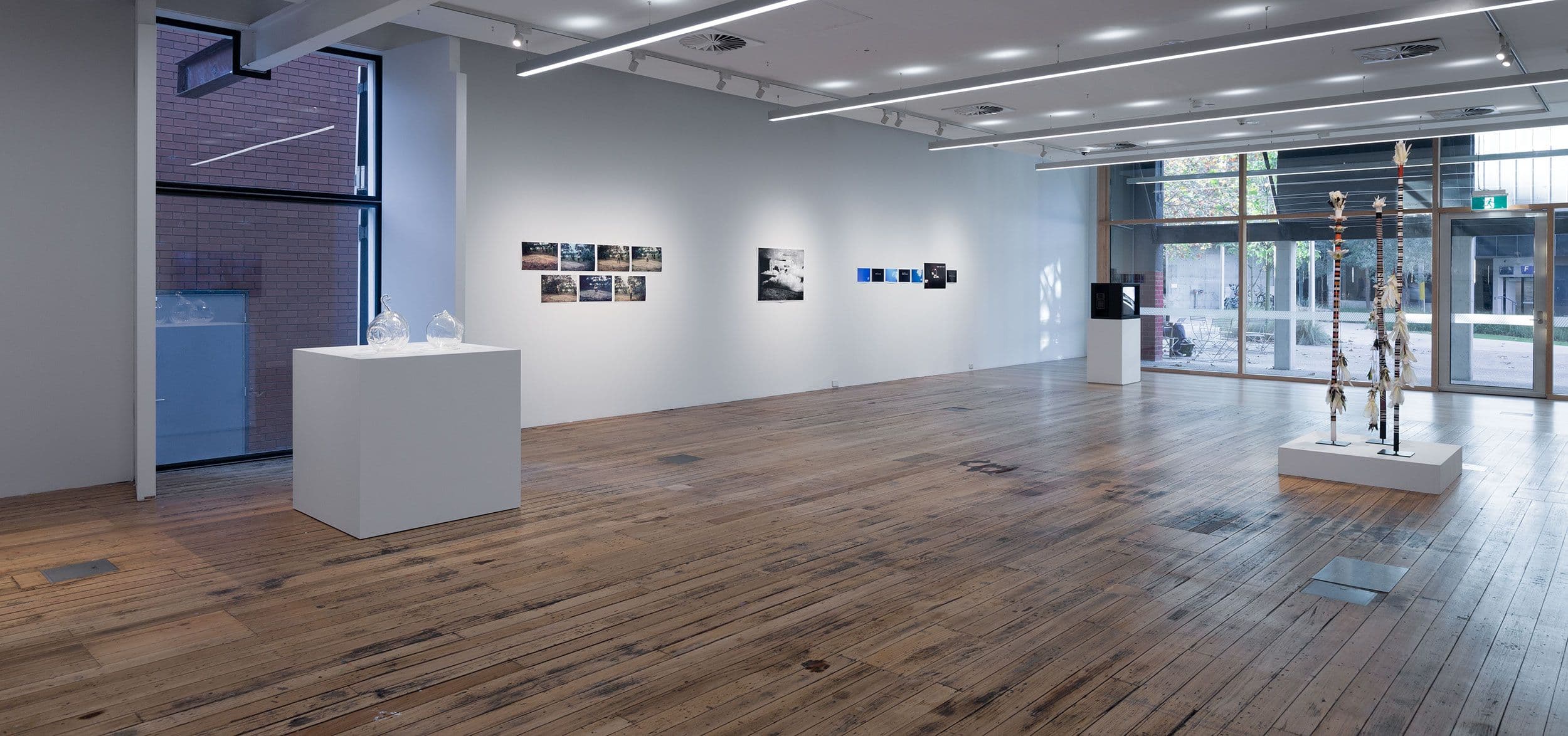
A Diachronic Wind, installation view, MADA Gallery, Monash University, Naarm/Melbourne, 2022, photo: Christian Capurro
The woman’s voice emanates from the future-oriented gaze of Lyndal Jones’ Prediction Piece 1 (1981–82), the first of ten performances from a broader series made over a decade. The work features Jones and performer Mary Sitarenos seated at and next to a desk within the George Paton Gallery, University of Melbourne. Their set up is administrative: Jones sits at a typewriter, transcribing Sitarenos’ reading of a script that is part weather forecast, part astrological and I Ching reading. The series investigates varied “act(s) of prediction”, methods and “processes through which we arrange our future(s) within our minds, and hence, our ability to plan, to intervene. It is an examination of the foundations upon which we can organise and create change.” Echoing our present moment, Jones work was conceived in response to a vast existential threat: “the prevailing fear at that time that there might be no future, that the event of nuclear holocaust was a foregone conclusion.” In selected slides that accompanied the performance–some reproduced here–images of blue sky with passing clouds are intermixed with others of white text on black. They read as part death-from above Cold War paranoia, part divinatory reverie. Language, however, is a crucial point of intervention for Jones. In the video, she transcribes fragments of the fuller predictions, returning to fill gaps with later, seemingly unrelated parts of the script. When complete, Jones reads the result to the camera; accompanied by a recording of the sound of this new script’s production. It is a fractured poem with strange insights at once personal and societal. The action offers a semblance of agency over the future at a time when mutual destruction felt preordained.
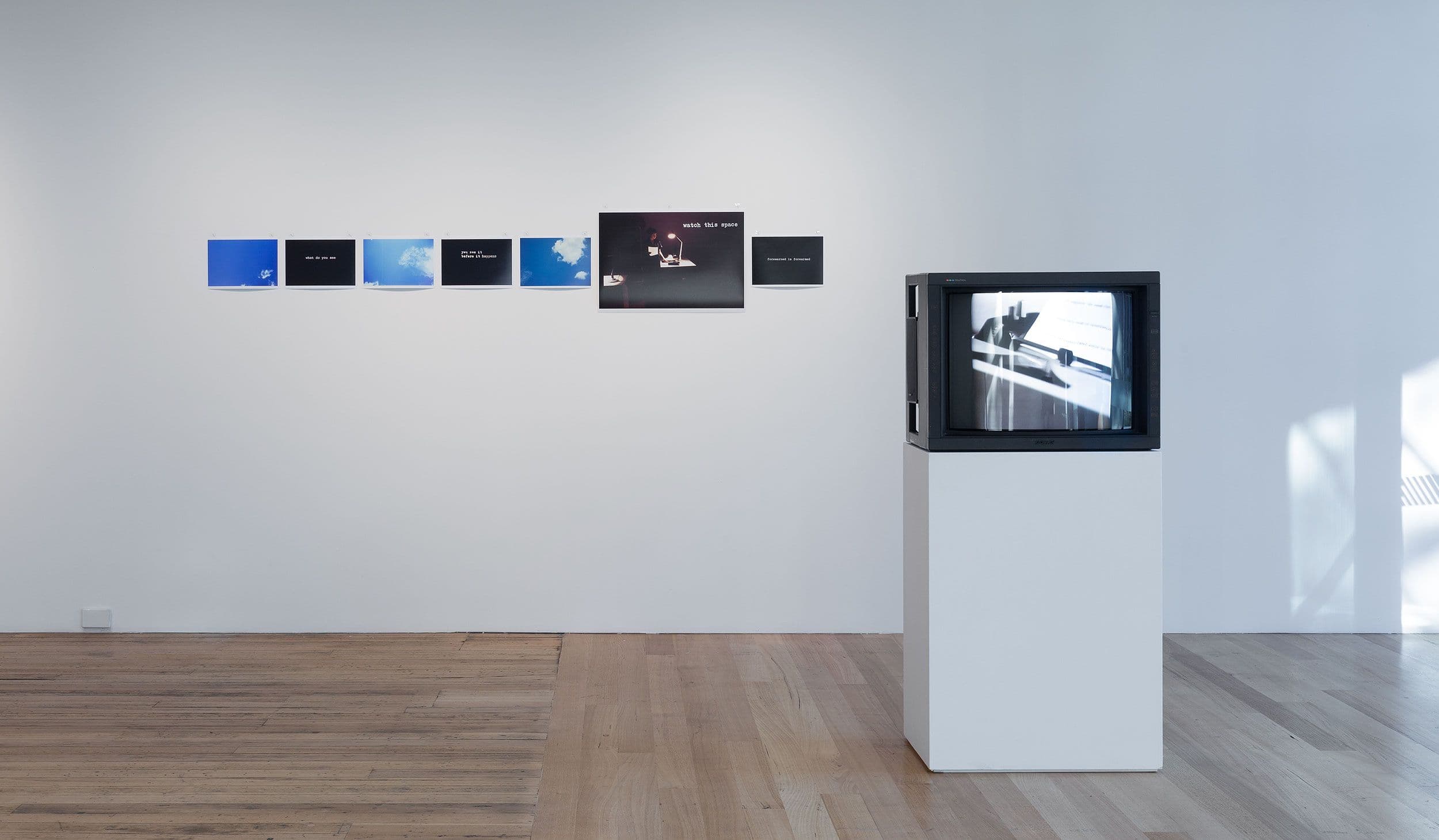
Lyndal Jones
Prediction Piece 1, 1981
Digital prints of scanned slides on paper, reprinted 2022; performance documentation, digital print on paper, reprinted 2022; U-matic video cassette converted to digital video, monitor, sound
6 parts, 29.7 x 42.0 cm each; 59.4 x 42 cm; 21:32 mins
Spoken word and multimedia performance, George Paton Gallery, University of Melbourne, Melbourne, 1981, with Mary Sitarenos, documentation by John Dunkley-Smith; re-presented in ACT 3: Ten Australian Performance Artists, Canberra School of Art Gallery and outdoor environs, October 1982, organised by Ingo Keinert
Courtesy of the artist. Photo: Christian Capurro.
Militaristic threat also colours Clive-Murray White’s Smoke bomb Sculpture (1971), both a durational performance and ephemeral land art. In the work’s documentation rising plumes are dragged by the wind, the product of smoke canisters Murray-White sourced from the Australian Army. They erase the orienting horizon line and background structures of the University of Queensland. Perspective becomes troubled, echoing their application on the battlefield. Though too early to reflect an ecological attentiveness, and nor intended to allude to it, Murray-White’s plumes also recall those of industrial pollution. The work sits at the intersection of dematerialised artistic practice–what Donald Brook might have described at the time as a “Post-Object Art”, impermanent and existing only through its documentation–and the heated political context of the Vietnam War and anti-war protests. The fume recalls similar environment-based attacks within Vietnam of defoliants like Agent Orange and the advent of ‘non-lethal’ gases such as CS, used also in the public domain as anti-activist crowd control. For Sloterdijk,
the twentieth century will be remembered as the age whose decisive idea was no longer to aim at an enemy’s body, but rather his environment . . . an attack on the enemy’s environment-dependent vital functions, namely breathing, regulation of the central nervous system and livable temperature and radiation conditions.
In WWII, atmosphere-borne military innovations included the use of DDT, an insecticide against mosquitoes to limit the risk of troops contracting malaria. DDT was shown to have disastrous impacts on human health and the environment broadly, and spurred the writing of Silent Spring (1962) by the marine biologist Rachel Carson – a historical turning point of the global environmental movement. Carson concludes the book by decrying these “most modern and terrible weapons” like DDT used by the military and science and the dark reality “that in turning them against the insects it has also turned them against the earth.”
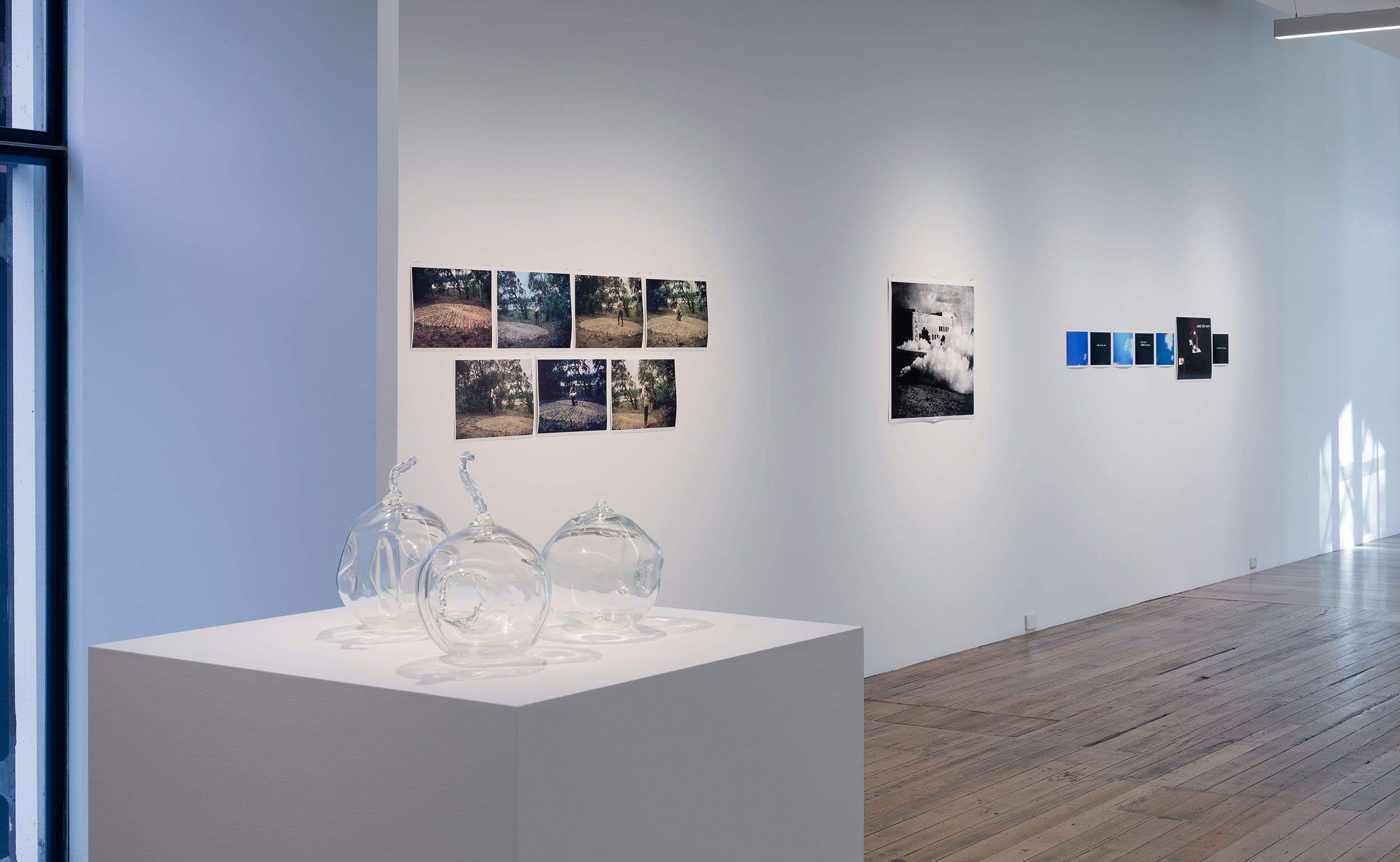
A Diachronic Wind, installation view, MADA Gallery, Monash University, Naarm/Melbourne, 2022, photo: Christian Capurro.
What then would an artistic practice that decentres the imposed hierarchy of human life above earth and air look like? Conveniently enough, if read via the environmentally focused work of Bonita Ely, then it begins by conflating insect and human. In Ely’s sculptural installation C20th mythological beasts: at home with the Locust family (1975) an anthropomorphised brood gathers on a couch in front of the television. Playing on the TV are “slides of beautiful NewYork Sunsets – aglow with the cocktail of pollutants lacing the Manhattan air,” presenting an “ironic critique of decadent modern living” and decaying of the romantic ideal of nature. In 1982, Ely was invited by the Canberra based Ingo Keinert who was organising ACT 3: Ten Australian Performance Artists, the final biennial in a series focused on performance art in the nation’s capital. Where some presented within the Canberra School of Art, including Jones who presented Prediction Piece 1, Ely chose to premiere a new outdoor, site-specific durational performance work, A Mother Shows Her Daughter to the Universe, incorporating interventions into the landscape of a circular sand mandala with lines of sprouting grass, within a pre-existing grove of trees. From the mandala’s centre a cross radiates outwards, oriented to the four cardinal points. Repeating lines intersect the mandala at 90°, representing the infinite cosmos. Ely’s earth work was activated by the artist and her new born baby, Marina. As an atheist, Ely was initially motivated to conceive of a substitute for a conventional Christening, intending to “invent a ritual that would signify and celebrate [Marina’s] entry into the universe, to life on Earth.” With her daughter in arm, Ely entered the site and enacted a series of actions: traversing and circling the cross and mandala’s curves, stopping at key points to present Marina firstly to the earth and then to the sky, acknowledging it as the gateway to the wider universe. In this way, Ely privileged a contemplative reverence for the majesty of the environment and beyond.
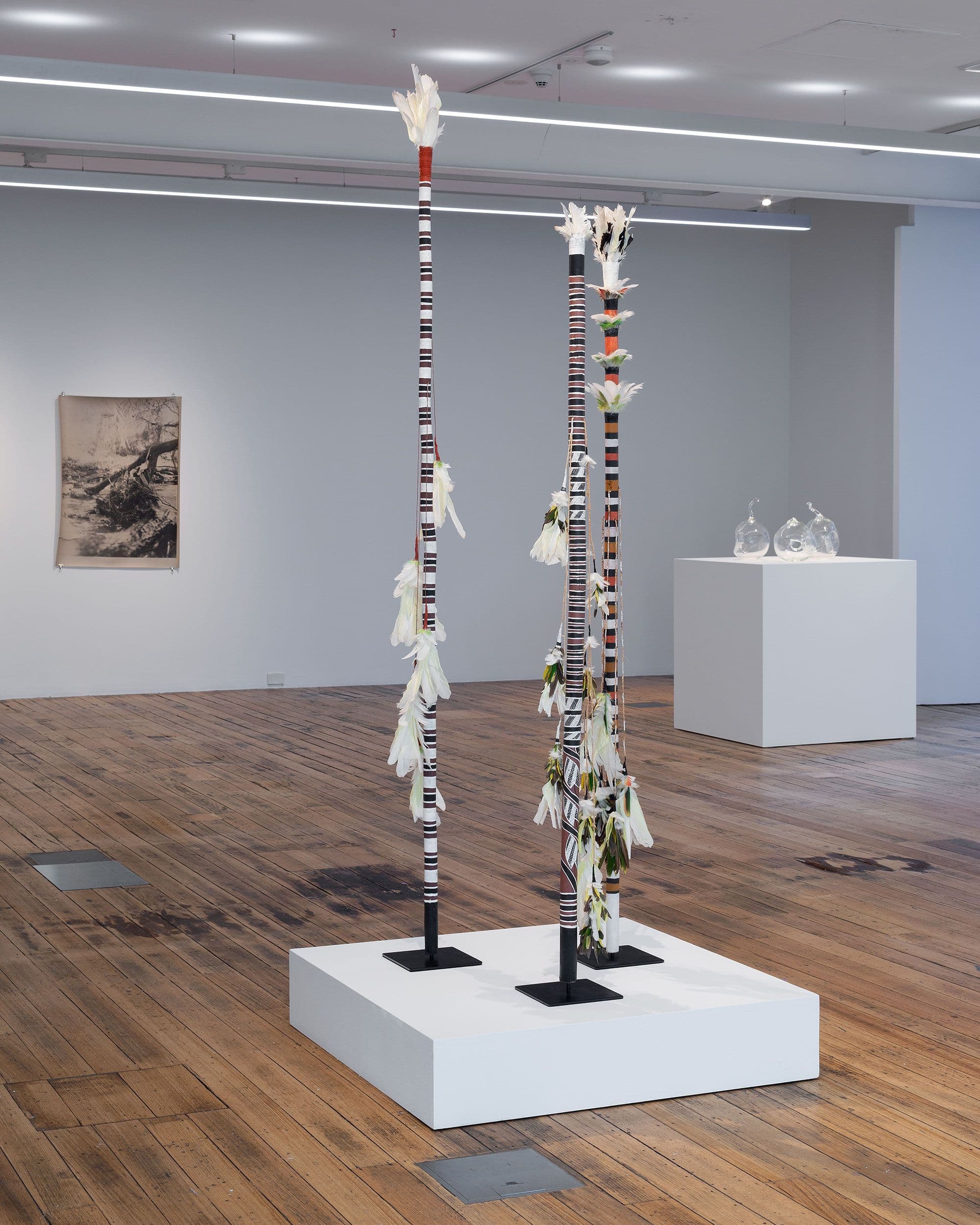
Malu Gurruwiwi, Banumbirr - Morning Star Pole, 2007–2008, natural earth pigment on wood with bush string and feathers, 186cm, Monash University Collection, Purchased 2009, Courtesy of Monash University Museum of Art; Banumbirr - Morning Star Pole, 2007–2008, natural earth pigment on wood with bush string and feathers, 190cm, Monash University Collection, Purchased 2009, Courtesy of Monash University Museum of Art; Banumbirr - Morning Star Pole, 2010, earth pigment on wood with bush string and feathers, 210cm, Monash University Collection, Purchased 2011, Courtesy of Monash University Museum of Art
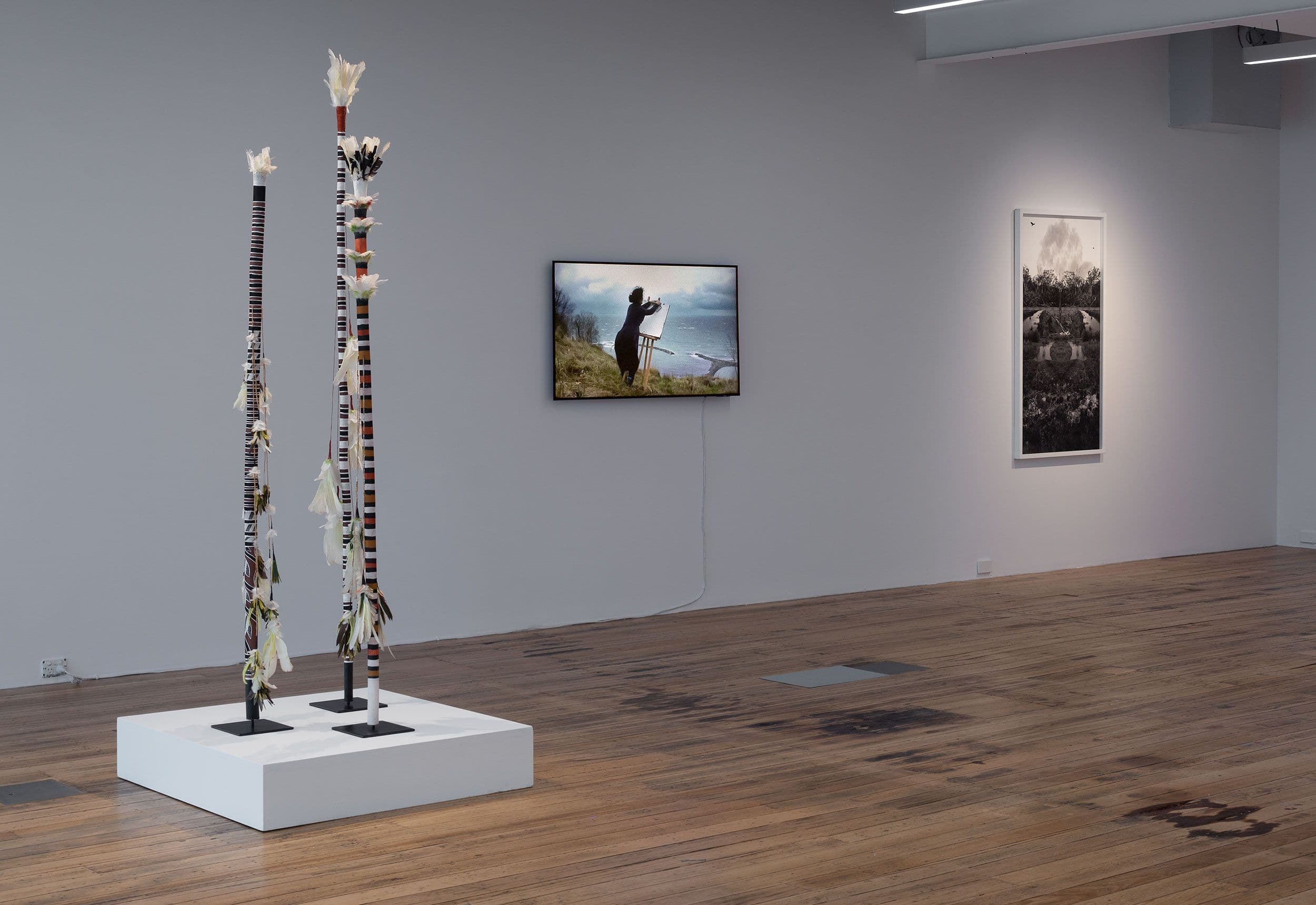
A Diachronic Wind, installation view, MADA Gallery, Monash University, Naarm/Melbourne, 2022, photo: Christian Capurro.
The atmosphere as an interstitial zone or bridge between the earth and the cosmos is also explicated in the late Malu Gurruwiwi’s Banumbirr – Morning Star Poles (2007–10). Utilised as ceremonial objects for dance, Morning Star poles such as Gurruwiwi’s express and embody the Yolngu people of East Arnhem Land’s close relationship with and reading of the movements of Banumbirr or Venus, the brightest star in the morning sky. Malu began his life on Milingimbi, also known as Yurruwi, off the coast of Arnhem Land, in 1942. Amongst the threat of Japanese bombing to the air force base situated on Milingimbi during WWII, Malu’s family was moved to Galiwing’ku (Elcho Island), where they lived within the Methodist Mission. In Yolngu knowledge–within which Gurruwiwi was a custodian of Banumbirr–the Morning Star is seen as a creator spirit and guided the first humans to Arnhem Land. Yolngu observation of Banumbirr’s low position in the sky is described as due to it being tethered to the ground by rope as a means of ensuring its safe keeping, which could be interpreted also as a metaphor for the interconnectedness of Earth-based life with the sky and beyond. In many Indigenous societies, reading the skies through the observation of atmospheric halos (the refraction of light around the moon or sun which announces the coming of storms) or the scintillation of stars (their twinkling) alerts observers to the change of seasons or native plant and animal changes. As Karlie Noon and Krystal De Napoli expand, for Aboriginal and Torres Strait Islander peoples the land and sky are “intrinsically and ceaselessly interlinked”, connected by detailed interrelations–or “threads” as the two describe them–that couple with ecological, medicinal, celestial and technological knowledge systems. This complex and expansive network–which Malu’s Morning Star Poles sit within–rebuts what Zoe Todd has called aer nullius, the Western presumption that the air and climate, like terra nullius’ fiction, “belongs to no one”.

Gabriella Hirst
Force Majeure, 2015–16
Single channel high-definition digital video
14:59 minutes
Monash University Collection, Purchased by the Faculty of Science 2016
Courtesy of Monash University Museum of Ar
As Noon and De Napoli argue, the visibility of these complex systems and the threads that connect them with each other is now presently at further risk. The ability to read the stars is being impacted by climate change as well as military and technological intervention in the form of space junk and light pollution. Similarly, the dominant, Western system of meteorology–entangled with unruly data and computation–is finding it increasingly difficult to predict the future and its weather. Those privileged or lucky enough to be watching on from afar, perhaps inured to such devastation by its quantity and frequency, may recognise in themselves a feeling that Sianne Ngai calls stuplimity: a contemporary derivation of the sublime, an aesthetic experience in which boredom is paradoxically conflated with astonishment. In this climate, foresight feels clouded. As James Bridle attests, as emissions worsen our thought is increasingly hampered: carbon dioxide directly degrades cognition and thus “our ability to think another way to be.” Gabriella Hirst’s Force Majeure (2015–16) is named for a common clause in contract law that absolves each party of liability in an extraordinary event or circumstance beyond their control, like extreme weather or a pandemic. Dressed in garb reminiscent of an era of plein air painting–close to the time of Ruskin’s observance of a strange wind–the artist sets up an easel and paper on a coastal cliff under ominously dark skies, in search of a Romantic, sublime view to capture. Hirst’s anachronistic scene reflects how contemporary life remains burdened by and mired in the past: stuck in economic processes that somehow privilege both waste and scarcity, as well as viewing nature as a submissive entity that humans control. The painter’s stubbornness implies a wilful inattentiveness to the conditions of the present, a deep disconnection from the visceral feedback systems that tell us something is wrong. Though extraordinary in their scale, the climatic events of the present and near future should not be seen as beyond our intervention: we each remain capable of informing what is yet to be, as well as ethically liable for our actions towards the planet.
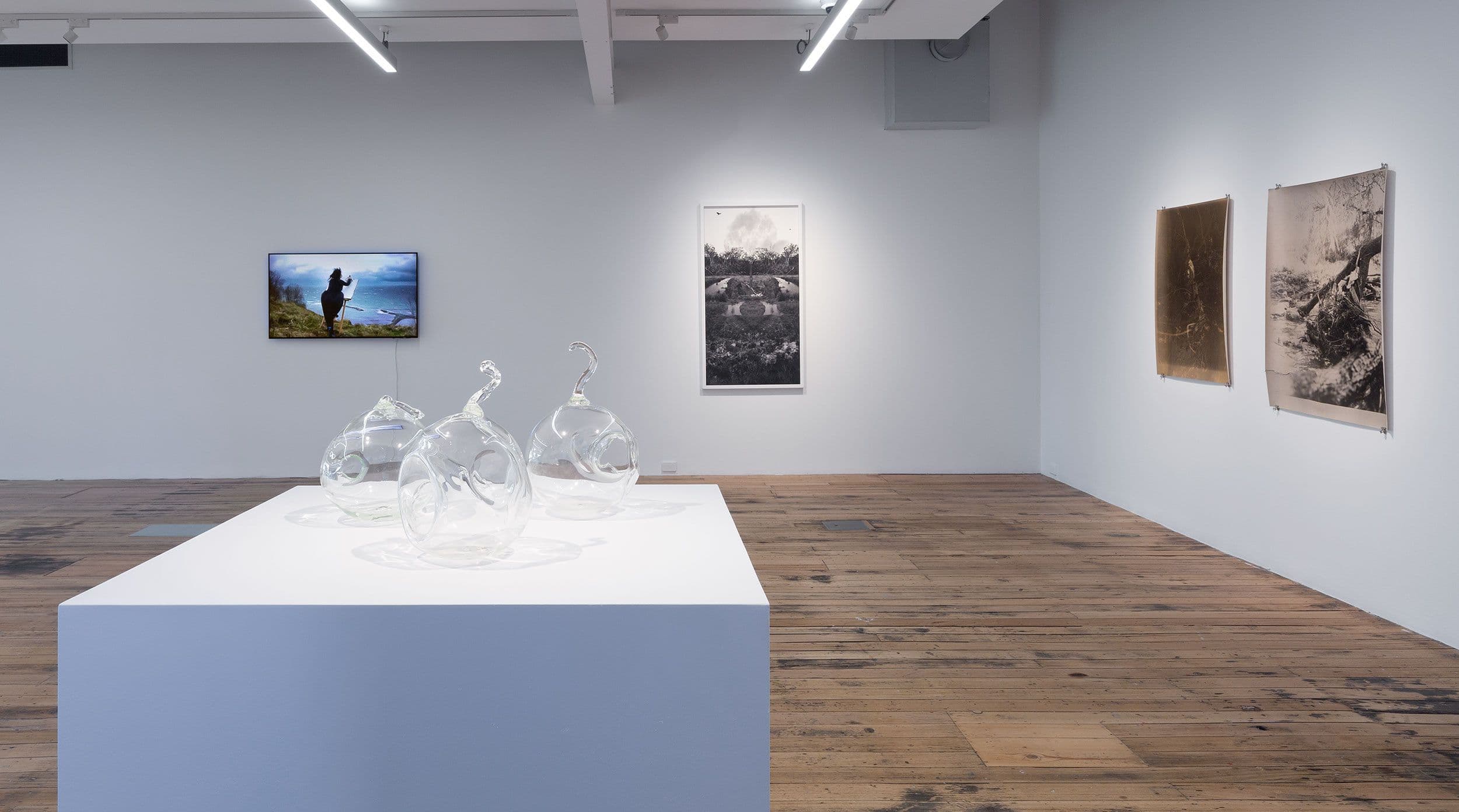
A Diachronic Wind, installation view, MADA Gallery, Monash University, Naarm/Melbourne, 2022, photo: Christian Capurro.
For T. J. Demos, where exactly blame should be laid for this predicament is a central point of his refutation of the Anthropocene – the description of our current geological epoch as one marked by the impact of humanity. For Todd and Heather Davis however, there is greater importance in recognising the start of the Anthropocene and thus global warming as embedded with the birth of colonialism, global trade and coal: dated to the Orbis Spike in 1610. Similar displacement and destruction followed British settlement of so-called Australia in 1788. In Hayley Millar Baker’s Even if the race is fated to disappear (Peeneeyt meerreeng / Before, now, tomorrow), no. 2 (2017) a sense of looking deeply into and across the Australian environment permeates. It is hard to place a distinct spatial or temporal position: as viewers, we are afforded a view from a multitude of positions that all co-exist within the one image. Time appears still yet moving, even converging. In the centre, a tree’s trunk stands upright, framed on either side by mirrored bodies of water. Above the bush in the background, a large cloud emerges. But is it a plume from a fire of ceremony or colonial destruction? For Millar Baker (Gunditjmara, Djabwurrung), the importance of these images is in their narrative openness and in the co-presence of temporal states: before, now, tomorrow, at once. This recalls conceptions of the demarcating of time in Indigenous thought. Though colonisation has wrought much damage, the environment in this image persists, the cultural continuum–reflected especially in the circling eagle and crow, important figures in South East First Nations’ creation stories–embedded within and in respect of it, persists. We are afforded a view here of how it was, and is, and will continue to be.
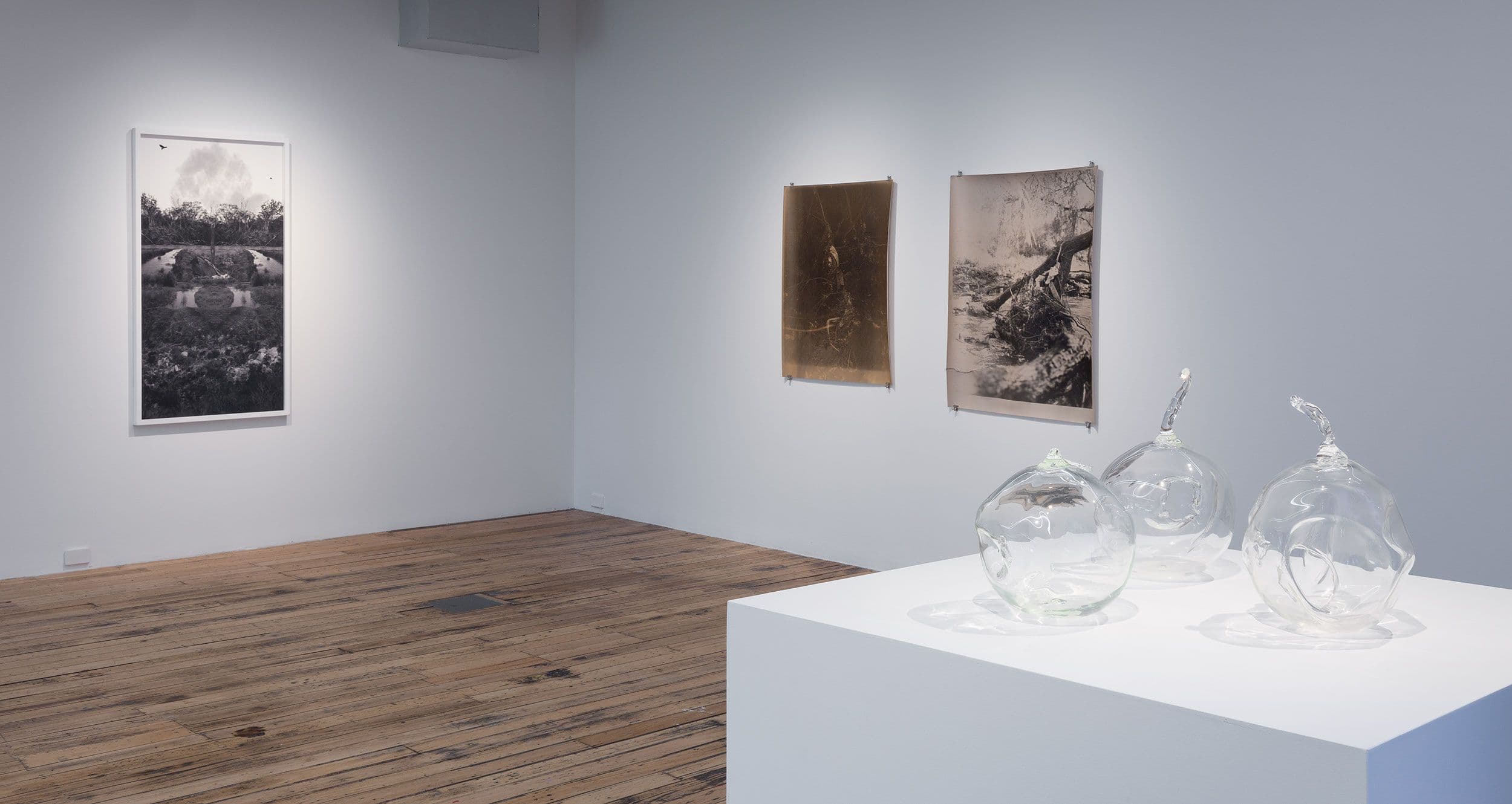
A Diachronic Wind, installation view, MADA Gallery, Monash University, Naarm/Melbourne, 2022, photo: Christian Capurro.
Camille Perry’s Where the Merri Meets Edgar’s Creek and To Make A Mends (2021) shares the anachronistic quality of Hirst’s video. In their sepia tones, the viewer could mistake these prints as late 19th or early 20th century in origin. At first, their monochrome veils the presentness of their subject, before enforcing its stubborn consistency: these images speak of detritus and waste accruing in waterways as both contemporary and historical scenes. For Perry, putting theory into praxis means working as a photographer in a way that makes the ecologically unsafe chemical developing and waste production of conventional analogue photography a footnote of the past. Hand developed and printed using a combination of coffee, vitamin C and washing soda, Perry documents these scenes before utilising her unique processing method to produce large-scale prints as well as film. Spurred on from her work within a large photography processing lab and having witnessed first hand the waste that it produces, Perry’s images both resolve a documentary image of current and damaging accretions in rivers and ecologies, but does so in a way that comments on their ubiquity while ensuring it does not contribute further to it in the process.
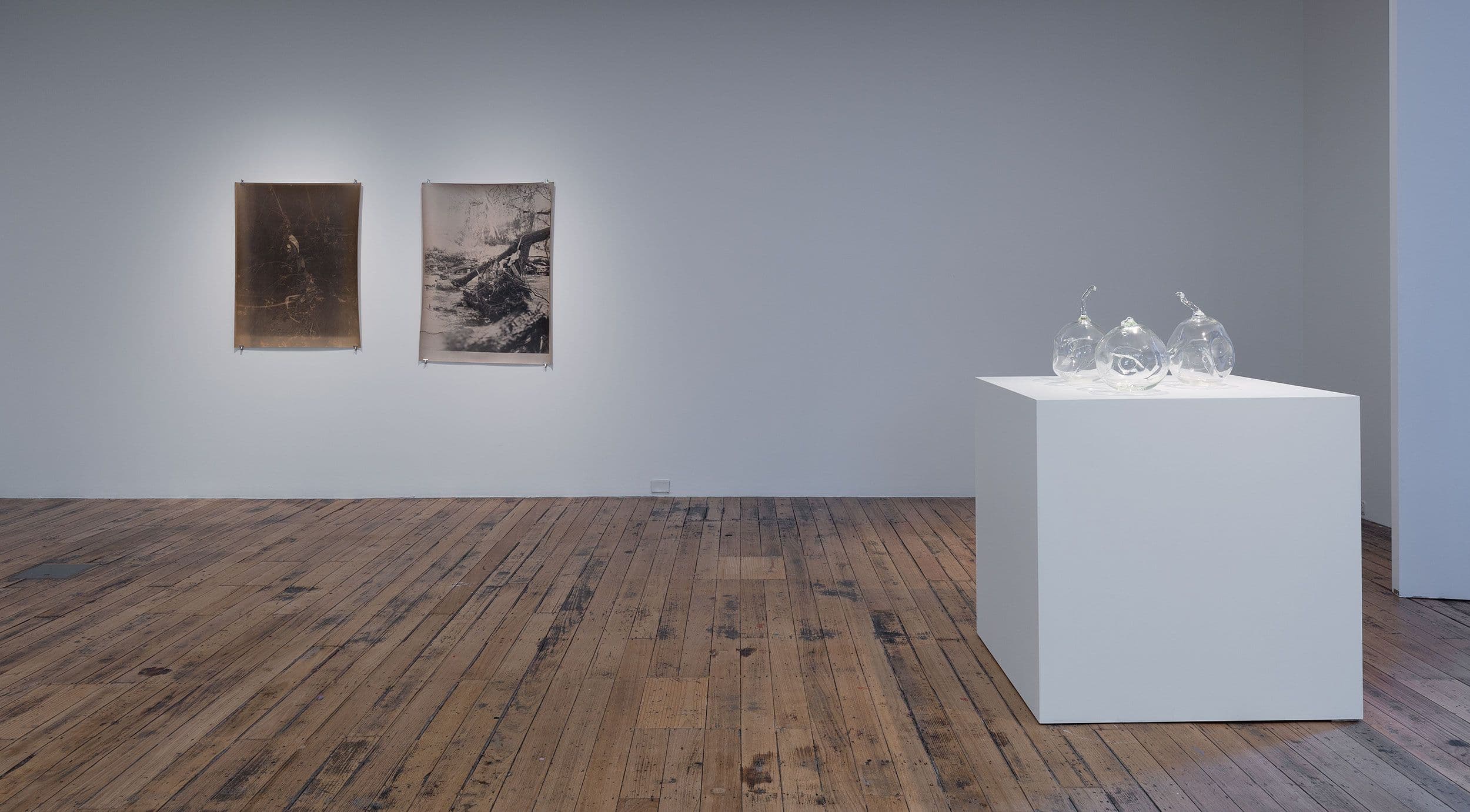
[Left to right] Camille Perry, Where the Merri Meets Edgar’s Creek, 2021, 170 x 120 cm; To Make A Mends, 2021, 180 x 120 cm, hand developed and printed with coffee, vitamin c and washing soda. Courtesy of the artist; Yhonnie Scarce, Nucleus 6, 7 & 8, 2020, hand blown glass bush plums, 3 pieces, approx. 25 x 30 x 25cm each. Courtesy of the artist and THIS IS NO FANTASY, Melbourne. Photo: Christian Capurro.
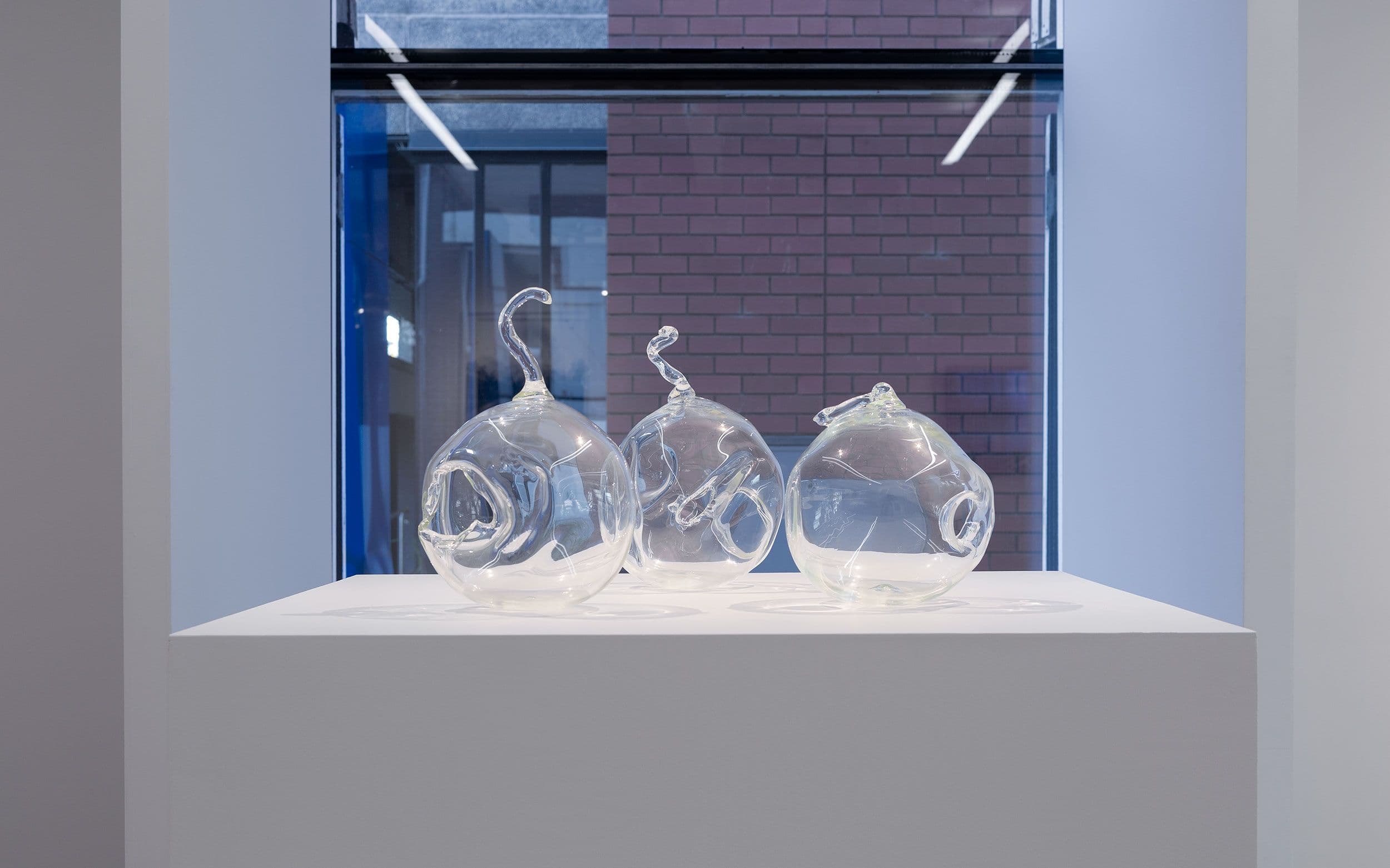
Yhonnie Scarce, Nucleus 6, 7 & 8, 2020, hand blown glass bush plums, 3 pieces, approx. 25 x 30 x 25cm each. Courtesy of the artist and THIS IS NO FANTASY, Melbourne. Photo: Christian Capurro.
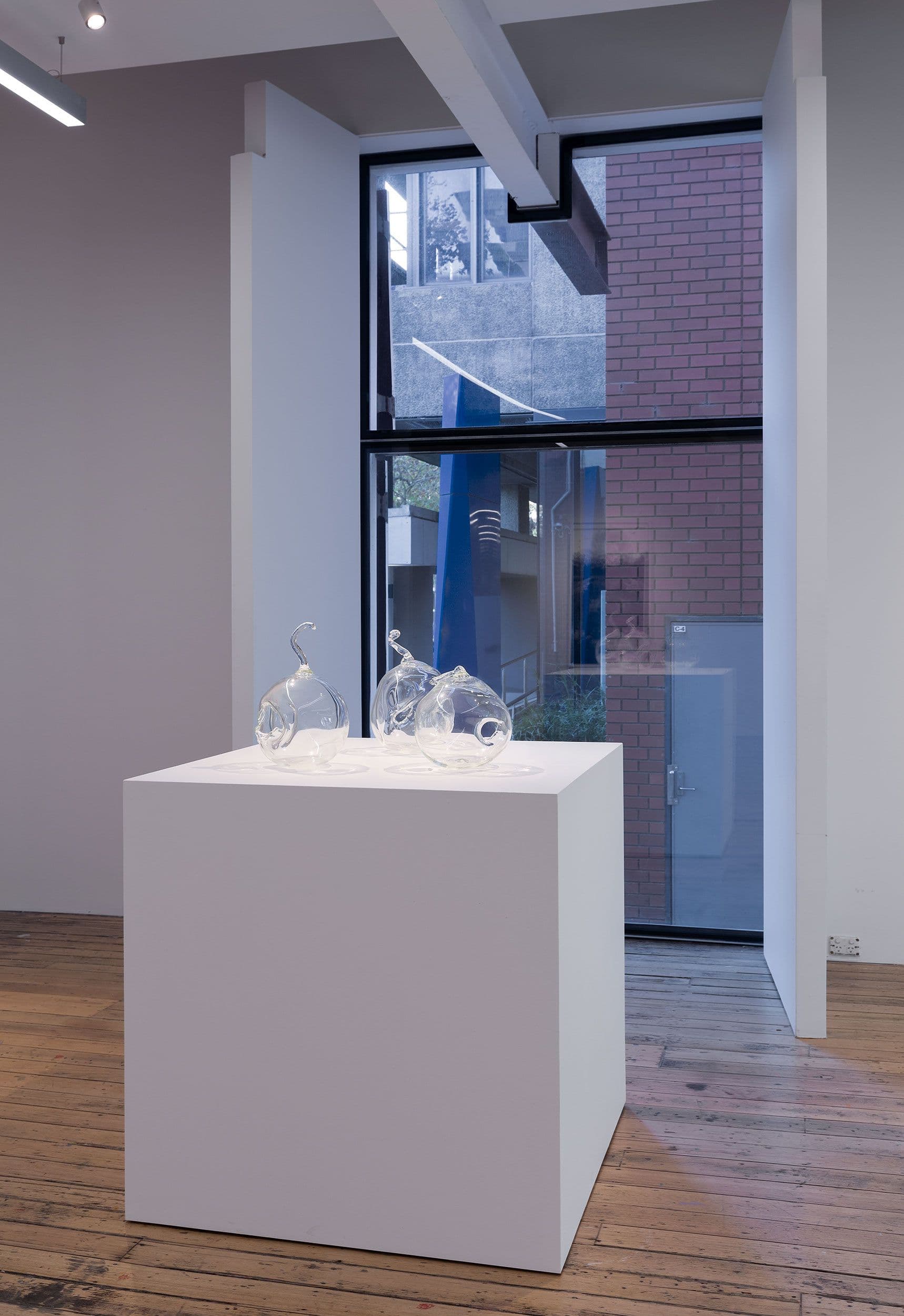
Yhonnie Scarce, Nucleus 6, 7 & 8, 2020, hand blown glass bush plums, 3 pieces, approx. 25 x 30 x 25cm each. Courtesy of the artist and THIS IS NO FANTASY, Melbourne. Photo: Christian Capurro.
The final work in A Diachronic Wind is Yhonnie Scarce’s Nucleus 6, 7, & 8 (2020). The ‘nuclei’ are in fact three bush plums made of hand-blown glass and created with a combination of extreme heat and Scarce’s breath. Their surfaces have either burst outward or inward, puckering like a mouth or wound. Scarce (Kokatha, Nukunu) and her work is closely bonded to the town of her birth, Woomera, which was established in 1947 at the beginning of the Cold War. Where the nuclear paranoia of the 1980s faded, Scarce’s practice dwells on the very real fallout of British nuclear testing conducted in Australia in the 1950s and 60s at Emu Field and Maralinga. As Daniel Browning notes, after the first tests at Emu Field in 1953, radiated plumes from that particular detonation blew across country. Yankunytjatjara and Pitjantjatjara Elders who observed “shook their spears at the sky and feared the ‘shiny, oily’ black mist that descended on the camp was mamu, a bad spirit.” The Elders’ description intriguingly echoes Ruskin’s observations of a dark veil and mist in his era. These tests’ violence plays out across varying temporal ranges: the immediate and terrifying–felt especially by the Traditional Owners of the lands within what is now called the Woomera Exclusion Zone–but also others more glacial in their destruction, playing out across millenia due to the half-life of atomic particles. For Rob Nixon, this constitutes what he calls slow violence: damage so extended across time that it challenges perception. With similar damaging lethargy as atomic half-lives, a quarter of emitted carbon dioxide is deposited in the atmosphere, circulating for millennia – and despite its disastrous effects, it remains largely imperceivable or unfathomable in its risk. A different kind of death-from-above. Thus, slow violence too provides a concluding lens for a deeper understanding of anthropogenic emission. Perhaps a wind of change is possible still, one to replace this strange, bitter, blighting wind, a diachronic wind, blowing now for centuries.
Notes
John Ruskin, The Storm-Cloud of the Nineteenth Century: Two Lectures Delivered at the London Institution February 4th and 11th, 1884, London: George Allen, 1884.
Nerea Cavillo, “Particular Sensibilities,” e-flux Architecture, accessed 5 May 2022, https://www.e-flux.com/architecture/accumulation/217054/particularsensibilities/.
Lyndal Jones qtd in Susan Cramer, “An Introduction to The Prediction Pieces,” in Lyndal Jones: The Predictions Pieces 1981-91, ed. Susan Cramer and Lyndal Jones (Sydney: Museum of Contemporary Art, 1991), 8.
Cramer, “An Introduction,” 8; Early research undertaken by Jones in 1980 for The Prediction Pieces in New York City documents a series of publicly accessible fallout shelters in plain sight on NYC streets.
Stephen Jones, “Donald Brook and post-object art,” Art Monthly Australasia 317 (Winter 2019): 78–80.
Due to its developments in atmospheric-based warfare, the Vietnam War has been sometimes referred to as “The Chemical War”, see David Biggs, “Vietnam: The Chemical War,” The New York Times, 24 November 2017, https://www.nytimes.com/2017/11/24/opinion/vietnam-the-chemical-war.html; Peter Sloterdijk, Spheres, Volume III: Foams, Plural Spherology, trans. Wieland Hoban (South Pasadena: Semiotext(e), 2016), 90–91.
Rachel Carson, Silent Spring, (New York: Houghton Mifflin, 1962), 300.
Nicholas Croggon, “Bonita Ely’s art of ecology,” Art & Australia 48, no. 1 (Spring 2010): 44; as Croggon elaborates, Ely was as equal an innovator in feminist practice too. Within a feminist environmental space, Ely’s contemporaries included Joan Grounds and Jill Orr, and across each of their practices at this time there was a shared interest in ritual and performance. This is explicated in Ely’s Jabiluka UO2 performance of 1979, which protested the uranium mining of the lands of the Mirrarr peoples in the Northern Territory, in an area surrounded by the World Heritage listed Kakadu National Park.
Email correspondence with artist, 16 November 2021.
Karlie Noon and Krystal De Napoli, Astronomy: Sky Country (Melbourne: Thames & Hudson, 2022), 59.
Noon and De Napoli, Sky Country, 75–82.
Noon and De Napoli, Sky Country, 43.
Zoe Todd and Heather Davis, “On the Importance of a Date, or, Decolonizing the Anthropocene,” ACME: An International Journal for Critical Geographies 16, no. (2017): 764, https://acme-journal.org/index.php/acme/article/view/1539/1303.
William B. Gail, “A New Dark Age Looms,” The New York Times, 19 April 2016, https://www.nytimes.com/2016/04/19/opinion/a-new-dark-age-looms.html.
Sianne Ngai, Ugly Feelings (Cambridge, MA: Harvard University Press, 2004), 271.
James Bridle, New Dark Age: Technology and the End of the Future (London: Verso, 2018), 72, 75.
Instead, Demos argues for the Capitalocene, the recognition that in comparison to the onus of responsibility being placed on individuals, it should be placed on Capital, see T. J. Demos, Against the Anthropocene: Visual Culture and Environment Today (Berlin: Sternberg Press, 2017).
Following ice core analysis, the Orbis Spike shows the dramatic drop in carbon dioxide levels following the colonial invasion of the Americas in 1492. An estimated 50 million people–many of whom were farmers–were exterminated whether through direct violence or the spreading of the airborne small pox. The drop in 1610 reflects the ensuing abandonment of farmland and its reclaiming by carbon-dioxide processing forests, see Simon L. Lewis and Mark A. Maslin, “Defining the Anthropocene,” Nature 519 (2015): 171–180.
See Stephen Gilchrist’s reading of W.E.H. Stanner in Everywhen: The Eternal Present in the Indigenous Art of Australia (Cambridge, MA: Harvard Art Museums, 2016), 19.
Daniel Browning, “Alchemy and Memory Politics,” Yhonnie Scarce: Missile Park (Melbourne and Brisbane: Australian Centre of Contemporary Art and Institute of Modern Art, 2021), 96.
“For the sky is covered with gray cloud;—not rain-cloud, but a dry black veil, which no ray of sunshine can pierce; partly diffused in mist, feeble mist, enough to make distant objects unintelligible, yet without any substance, or wreathing, or color of its own.” See Ruskin, The Storm-Cloud.
My description of Scarce’s relatedness to Rob Nixon’s concept of slow violence is informed by Jacob Warren, “Apprehending the Slow Violence of Nuclear Colonialism: Art and Maralinga,” in Genocide Perspectives VI: The Process and the Personal Cost of Genocide (Sydney: University of Technology Sydney, 2020): 129; see also Rob Nixon, Slow Violence and the Environmentalism of the Poor (Cambridge MA: Harvard University Press, 2011).
A Diachronic Wind
Curated by Tim Riley Walsh
Artists
- Bonita Ely,
- Malu Gurruwiwi,
- Gabriella Hirst,
- Lyndal Jones,
- Hayley Millar Baker,
- Clive Murray-White,
- Camille Perry,
- and Yhonnie Scarce
19 May – 4 June 2022
MADA Gallery
Ground Floor, Building D
Monash University
900 Dandenong Road
Caulfield East VIC 3145
Australia